Building a Bamboo Bike - Part One: The Frame
Just as I announced in my last bike post, I jumped right into a bike-building workshop. The inspiration came from Arthur, my most recent warmshowers guest, who is riding around the world on his bamboo bike. He came to Mexico City specifically for one reason: to get to know BambooCycles, the bike shop specializing in bamboo frames, which is conveniently located just five minutes walking distance from where I live.
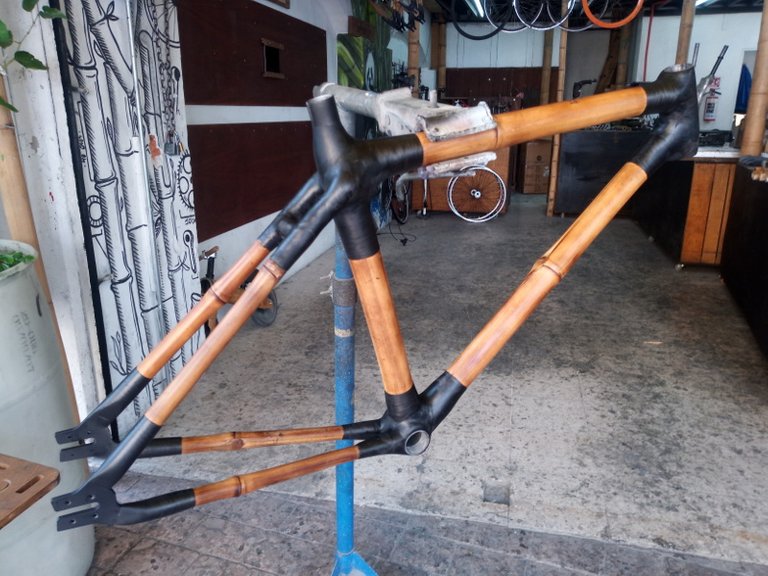
Though I had dropped in once to look at the place, and inquire about the cost of their frames, I never even thought about taking a course. In fact, I may never have done it hadn't it been for Arthur. In the end I'm glad that I signed up for the course, and remain grateful to my guest for sparking my interest. After roughly a week of off-and-on work, I can finally say I have completed a beautiful bamboo frame! So the next steps are a bamboo fork, a bamboo handlebar, and a set of other components that will complete a bicycle. For now, however, I want to present the highlights of the building process:
Starting out with Some Sticks
What is a frame, really? It's something to keep together the seat post (for the seat), the bottom bracket (where the cranks go), the headset (to attach the fork), and the dropout (for the rear wheel). All of these attachments require metal pieces, but the frame itself can be made out of bamboo. This wonderful material has numerous advantages: it's much lighter than steel, it won't rust, but it doesn't have the annoying rigidity of aluminum. Bamboo is a type of giant grass, so it's a fully natural, renewable product, and if grown sustainably it can have the added benefits of water management and habitat creation, mulch, (etc. etc.). From among the myriad of bamboo species, the one used for bike building is the Dendrocalamus strictus, chosen for its non-splitting properties.

Assembling the frame is really quite straight forward: we use strands of carbon fiber, glued together by epoxy resin, to keep the bamboo pieces and the metal fixtures together. For this reason, the parts of the bamboo that will be covered in carbon are peeled, and the rest is covered in a plastic wrap for protection. Eventually the carbon fiber will join all the pieces, as illustrated in the cross-cut frame, hung up at the shop for demonstration purposes.

A Dream of a Fixie
Depending on the type of bike, the frame can have various geometrical aspects, to give the rider the best position for speed, for climbing mountains, for a leisurely ride to the bakery, or performing mind-blowing tricks. At first I liked the Durango model because it was the most similar one to my Zorra Roja, the touring bike I built for my trip down the West Coast last year. But then I realized that riding around in Mexico City requires a different type of bike.
One of the many challenges this city poses, are discontinued bike lanes, or other factors that would force you to go through curved tunnels, where motorists are speeding through along shoulderless lanes. The alternative usually includes carrying your bike up and down pedestrian bridges, clearly the preferable option, especially if your bike is light, and stripped of any unnecessary components and accessories. Such a dream of a fixed gear bike is the Insurgentes model. Finally, I won't be the only horizontal dropout here!
Putting it all Together
This part of the work could be the hardest, and most frustrating one... if you didn't have the assuring experience of the guys at BambooCycles. Fortunately, they know exactly where each piece has to go, and with their nifty frame-building-frame this precision work can be completed in a few minutes with doubtless exactness.

The fork and the wheel seen here are only used for measure, which is why they are covered in epoxy, just like the entire work surface. Once you get your hands into the sticky stuff, it becomes quite clear why the plastic foil is needed: it's simply unavoidable to get the resin onto everything! Needless to say, it's best to wear clothes that are on their last thread anyway.
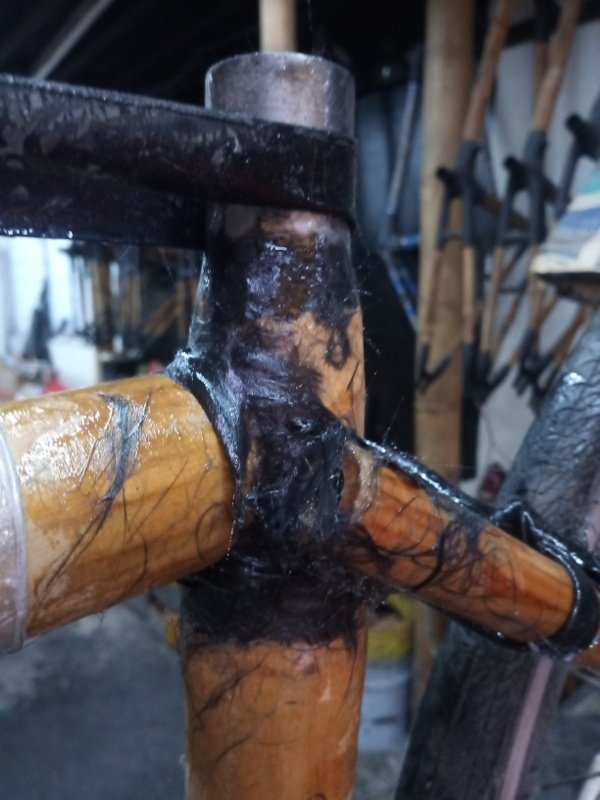
Using shorter pieces of carbon fiber, immerse them in the resin mix, you stick the pieces together. Next, you use strands of medium length (approx. 10-20 cm) to cover the joints on the outside. Then you wrap them in a generous layer of long strands, similarly saturated in epoxy resin. This fiber looks a lot like hair! This realization has been brought up and discussed so much during the workshop, that I had to look into it.
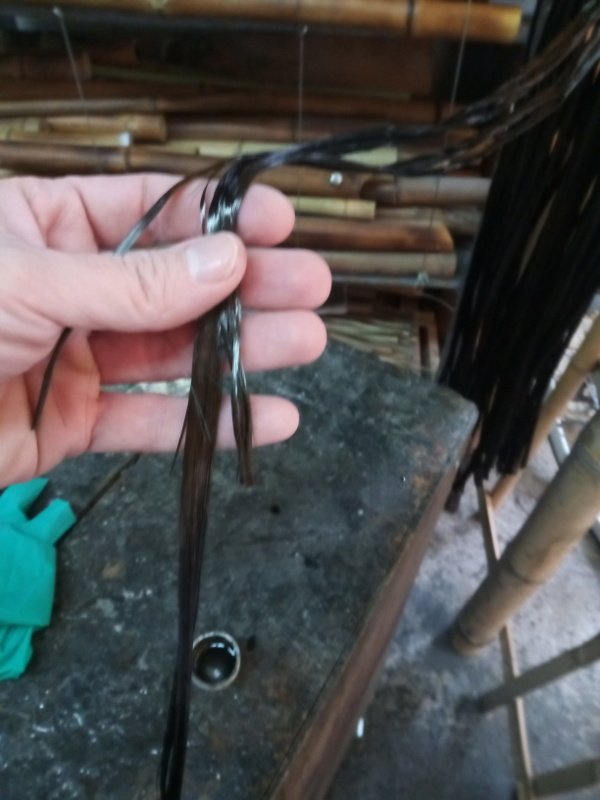
After all, our hair (just like the rest of our body) is mostly carbon, and is known for its great strength. However, it seems like it is still no match for the carbon fiber. According to this source, carbon fiber can be 2-3 times as strong as our hair. Good to know. Still, in order to hold a bike frame together human hair may be just sufficient. I may come back to this idea for my next bamboo bike. Till then I'll let my hair grow a bit longer.
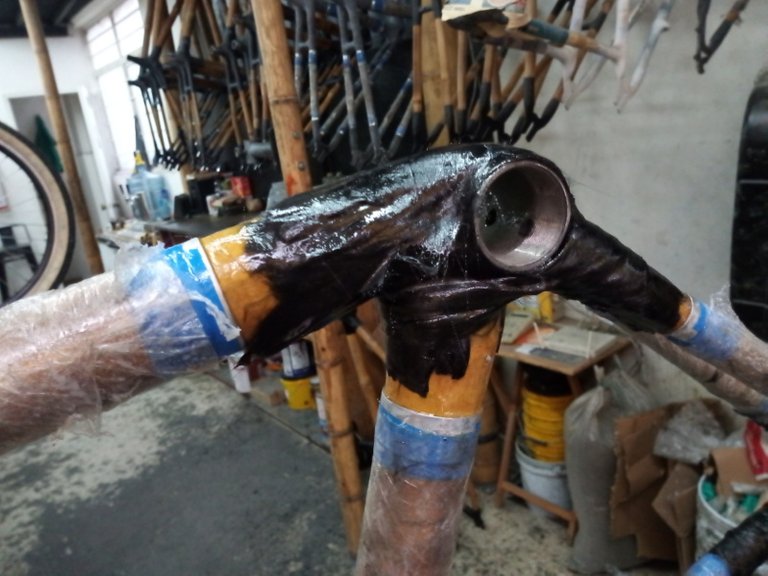
Most of the Work: Sanding, Sanding, and more Sanding
Once the joints have hardened, giving the frame the desired strength, you could say that most of the work is done... leaving only the non-essential cosmetic work. That may be true, but the sanding is actually what takes most of the time and energy in this frame-building process. And though it may not be strictly essential, skipping it would leave the bike in an ugly shape.
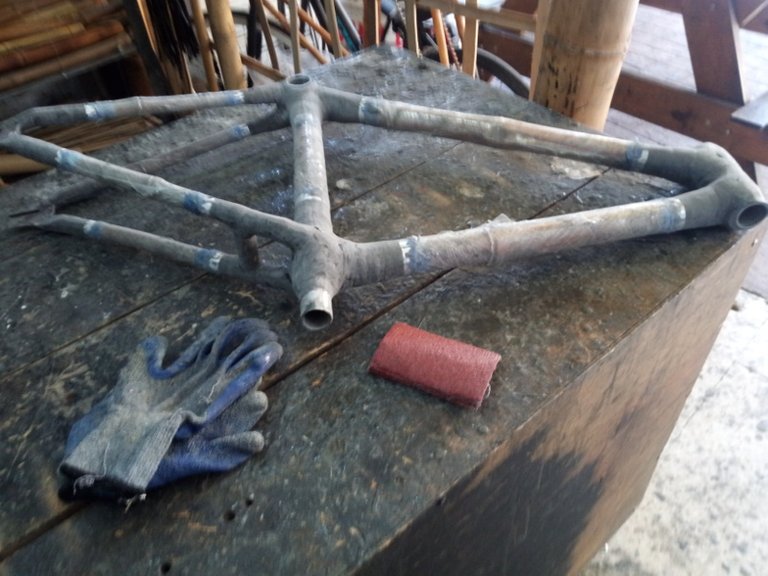
Take the head tube for example and observe the huge dents and holes all over it! These used to be air pockets between the strands of fiber. Though it is theoretically not inevitable, these kind of holes tend to appear regularly in all the carbon fiber parts. The solution is to sand it all down. At this point I should mention to cover as much of your body as you can, because this carbon dust can be quite itchy, especially when it gets onto your neck or arms.

If there are still remaining holes, even after hours of sanding, they can be filled with a mix of metal filler, hardener, and black pigment. As tempting as this method may seem, it requires another round of sanding, getting rid of the excess paste on the outside, making sure that you don't sand the pieces away that were supposed to fill the holes. The whole process may need to be repeated.
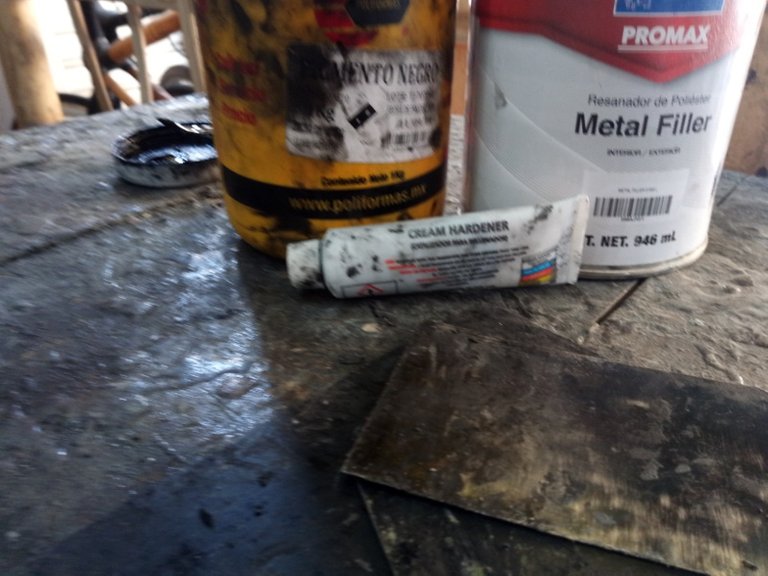
When all the holes are filled and the carbon pieces have taken on a nice shape, you can switch the sandpaper for one with a finer grain, and continue sanding away the scratch lines. Over a course of several hours I went from 36 to 100 to 230. Eventually the rough sanding becomes smooth polishing. At this point even the protective plastic layer can be removed, so the bamboo can be given a very gentle sanding.
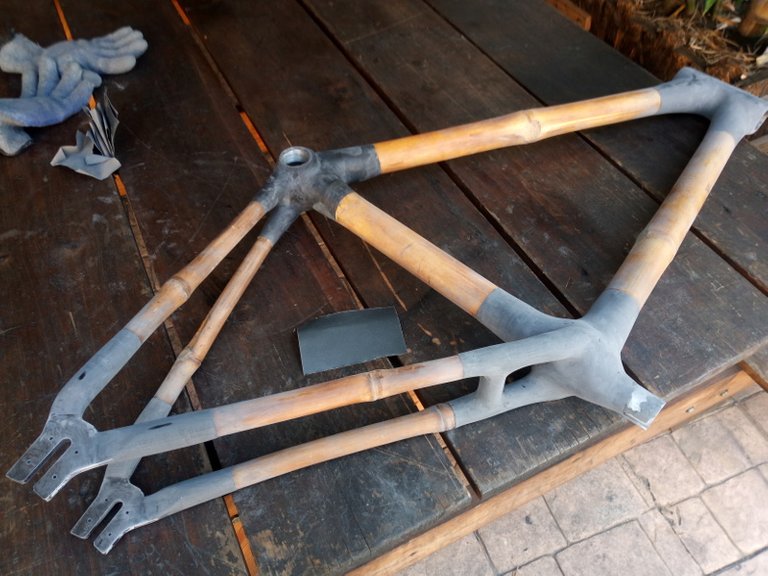
Once all the sanding has given the frame a satisfactory look, the entire thing is covered in a generous layer of bee's wax. This is why even the bamboo got a light sanding, to open up its pores for the wax. It is recommended to repeat this last step regularly, as part of bicycle maintenance. The wax is absorbed into the bamboo, where it protects it from getting wet, or drying out. If kept up properly, a bamboo frame can have the longevity of frames made of other materials.

Well, that's how I built myself a bike frame of bamboo. Please stay tuned for the next parts of this series, where I document the building of the bike.
Please check out these great communities I'm contributing to:

#ecotrain | What is EcoTrain | Discord Community

#tribesteemup |The 8 Pillars of @TribeSteemUp

#team-mexico | Discord Community


#cyclefeed | Introducing CycleFeed | Discord Community
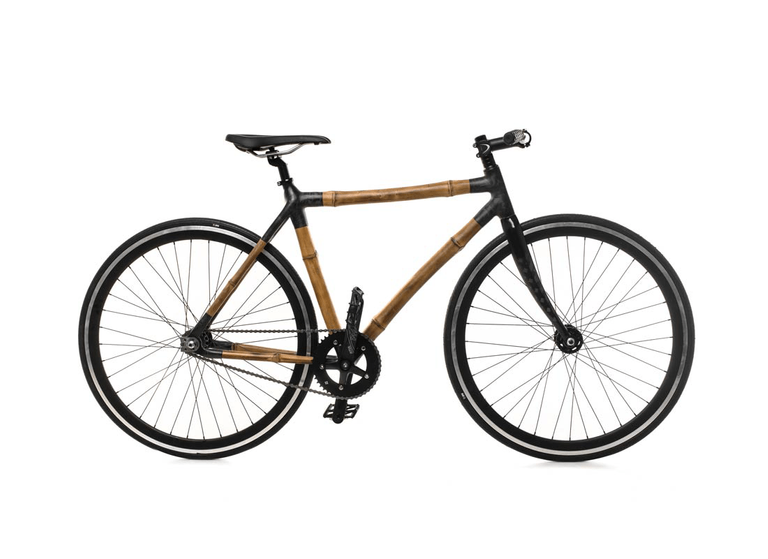
This post was shared in the Curation Collective Discord community for curators, and upvoted and resteemed by the @c-squared community account after manual review.
@c-squared runs a community witness. Please consider using one of your witness votes on us here
This is super awesome. I've been wanting to build my own bike from scratch for a while but i'd more likely start with an old reynolds frame.
Did you see Sean Conway doing his cycling challenges on a bamboo bike. they were pretty cool.
Thanks for your comment. This calls for a !BEER
And I agree: it's best to start out simple. My first bike was also a regular steel frame (a Kona Hahana from 1993 to be exact), where the objective was to build a solid touring bike out of recycled parts. It turned out to be a super sweet ride, which is still waiting for me in L.A. to complete... or better continue the trip.
As for Sean Conaway, I have to admit I'm really bad at celebrities, even the cool ones. I recognize the name, but that's about it. I don't think I've seen anything with him in it, but then again, I may have without realizing it.
View or trade
BEER.Hey @markangeltrueman, here is a little bit of
BEERfor you. Enjoy it!That is amazing, i hope i see them everywhere
So do I! The funny thing is, though, ever since I started paying attention to bamboo bike frames, they keep appearing everywhere!
Being bamboo, you might say it is a grass roots movement.
I am sure there is a slogan in that
Awesome! Haven't even thought of that! :-)
Your post has been curated by the bitcoin myk project. Tokens are available for this account you can trade for steem at: https://steem-engine.com/. Join our curation priority list to earn more tokens by registering at:
http://www.bitcoinmyk.com/register/
Bitcoin MYK
admin
Register - Bitcoin MYK
Very nice craftsmanship!
Posted using Partiko iOS
Thank you very much!
Congratulations @stortebeker! You have completed the following achievement on the Steem blockchain and have been rewarded with new badge(s) :
You can view your badges on your Steem Board and compare to others on the Steem Ranking
If you no longer want to receive notifications, reply to this comment with the word
STOPTo support your work, I also upvoted your post!
Do not miss the last post from @steemitboard:
Vote for @Steemitboard as a witness to get one more award and increased upvotes!
Amazing I love this, I want one haha 💯🐒
Sure, do you want me to make one for you?
Would consider it but what would the cost be then postage to UK would crank it up considerably 😬 💯🐒
Let me find out...!
...and I did! Using the shipping calculator on the BambooCycles website, I found out that shipping to London would be between $100 and $225 USD (roughly 80 - 180 GBP), depending if you want just the frame or an actual bike. In my case I really would like to build a fork and handlebar out of bamboo too, so that would put the price somewhere between the two, provided you don't want wheels and other components. Also, please keep in mind, these are the prices for London. The more remote your address, the more it will cost to ship there.
Hey @vibeof100monkeys, I got all the bamboo parts finished. Are you still interested in it? Check out this post with my offer: https://steempeak.com/@stortebeker/a-bamboo-bike-for-cryptos 0.1 BTC including shipping!
Hoo-Lee-Cheese! Just the other day I was talking to a friend about the bamboo frames and now seeing your tutorial I really want to try it out - I don't think it would be difficult to find the materials in Brazil.
Well, they say that the best bamboo comes form Vietnam and Mexico, but not because it's endemic there (okay, Vietnam maybe) but because it's grown in huge quantities. Still, it would really surprise me if other countries with similar conditions (Thailand, or Colombia, or China, or Brazil) didn't have the right type of bamboo for a bicycle. Look around, and I'd be excited to read what you've found.
Congratulations @stortebeker! Your post was featured on our daily build newsletter! We set you as a %15 beneficiary of our newsletter rewards. You can see your post on our instagram Facebook and Twitter pages.
Keep sharing your awesome DIY and How-to tutorials together with the recommended tags #diy, #build-it, #how-to, #doityourself, #build as well as posting from our website
Wonderful!
Thank you.
this is awesome @stortebeker so very impressive xxx
Thank you so much for all your praises! :-) It really makes me super happy each time I see such a comment.
Can we find the frame already buylded for sale?
Well, BambooCycles has all kinds of frames as well as bikes they sell world wide. But if you're interested in buying MY frame, I'd feel honored! Though first I wouldn't mind adding a fork and an handlebar (both out of bamboo), if not the wheels and everything else. Where abouts in the world do you live? Just so to get an idea about shipping fees. I already told @vibeof100monkeys I'd find out about how much it would be to ship it to the UK.
For me it doesn't matter from where I buy it as long it is strong and you could rely on it.I like ideea because bamboo frame is wery light.
What price,shoud I expect?
Shiping in Romania.
Well, I'd say somewhere between €500 and €750, depending on if you just want the frame, (plus headset, fork, stem, handlebar, and grips), or an actual bike with a pair of wheels and the rest of the components. Shipping is on top of that, which I still have to look into how much it is. But now that there's two of you, I'll do it this week.
Okay, I did it! I didn't have to go too far, I just used the shipping calculator on the website of BambooCycles. Unfortunately it couldn't give me a fee for Bucatesti, or anywhere else in Romania for that matter. So I'm going to have to contact UPS (and possibly other courier services) for that. However, as you can see in the other thread, to ship it to London would be between $100 and $225 USD, depending if you want just the frame or the whole bike. I'll let you know once I've gotten a price estimate.
Hey @dromihete, I got all the bamboo parts finished. Are you still interested in it? Check out this post with my offer: https://steempeak.com/@stortebeker/a-bamboo-bike-for-cryptos 0.1 BTC including shipping!
hy man.onnestly I didn t expect at this price...for moment I must ways until better times will come.
Hope you understand.Thanks.
Sure, no worries. Though I'd be interested in the price you would expect for a bamboo frame set.
what! this is so so cool! how awesome that your guest inspired you to check it out- and 5 min from your house! i'll have to book mark this for future reference.
Yes, please do! It's a really amazing little shop, and apparently there are not too many of them around.
And bamboo is a wonderful building material, it's just that Western culture is not very used to applying it. But if you can build multi-story buildings with it, it should make a super strong bike frame - and it does.
Do you think the climate on your lad would support bamboo? Or do you rather not introduce non-native species?
that's so cool! how lucky it's 5 min from you. we do have a native bamboo species - native to north america. we call it river cane. but it splits and i noticed you used a non-splitting variety. not opposed to introducing bamboo- it's such a useful species! we have a friend who grows it about a half an hour from here. she's 70 now and her bamboo must be at least 30 years old- some of it is taller than her two storey house. definitely intrigued!
I was actually pretty surprised myself to learn that there are non-splitting varieties of bamboo. But even the splitting ones are so versatile and can be used for so many things, from art to household items, furniture... even construction. I don't know how strong river cane is, but it sounds like your friend has some huge types.